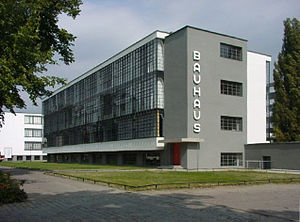Walter Gropius
From Wikipedia, the free encyclopedia.
Walter Adolph Gropius (May 18, 1883 – July 5, 1969) was a German architect and founder of Bauhaus.
Born in Berlin, Walter Gropius was the third son of a building advisor to the government with the same name, and Manon Auguste Pauline Scharnweber (1855 – 1933) whose family owned a manor near Berlin.
Gropius was an architect, like his father before him. He designed buildings using modern materials like concrete on steel-frame construction and glass brick. His works are often compared to abstract paintings. In 1919 he founded the Bauhaus, a school of design where students were taught to use modern and innovative materials and mass-produced fittings, often originally intended for industrial settings, to create original furniture and buildings.
Gropius married Alma Schindler after the death of her husband Gustav Mahler, and they had a daughter, Manon, in 1916. When Manon died of polio at age seventeen, composer Alban Berg wrote his Violin Concerto in memory of her. Gropius' marriage to Alma did not last. Alma later remarried, to Franz Werfel. Gropius and Alma are mentioned in Tom Lehrer's song "Alma".
Gropius fled Germany in 1934 due to the rising power of the Nazi Party, and lived and worked in Britain, at the Isokon project, and then, from 1937 to the United States, where his own house, the Gropius House in Lincoln, Massachusetts, was influential in bringing International Modernism to the US. Gropius did not like the term: "I made it a point to absorb into my own conception those features of the New England architectural tradition that I found still alive and adequate." [1]. Gropius and his Bauhaus protégé Marcel Breuer both came to Cambridge, Massachusetts to teach at the Harvard Graduate School of Design and collaborate on the company-town Aluminum City Terrace project in Pennsylvania, before their professional split in 1941. In 1944, he became a naturalized citizen of the United States.
In 1945, Gropius founded The Architects' Collaborative (TAC) based in Cambridge with a group of younger architects. The original partners included Norman C. Fletcher, Jean B. Fletcher, John C. Harkness, Sarah P. Harkness, Robert S. MacMillan, Louis A. MacMillen and Benjamin C. Thompson. TAC would become one of the most well-known and respected architectural firms in the world.
Gropius died in 1969 in Boston, Massachusetts at age 86. He was known to have a snappy sense of style and was often seen wearing a bowtie.
Among his students was the writer and theorist Siegfried Giedion.
Important buildings
- the Fagus Works, 1910–1911, Alfred an der Leine, Germany
- the Bauhaus, 1919–1925, Dessau, Germany
- the Gropius House, 1937, Lincoln, Massachusetts
- the Harvard Graduate Center (1949–1950), Cambridge, Massachusetts (Architects Collaborative) [2]
- the University of Baghdad (1957–1960)
- the John F. Kennedy Federal Building (1963–1966)
- the Attleboro Junior High School (1948)
- the Pan Am Building (now the Metlife Building), (1958–1963), New York, New York, with Pietro Belluschi and project architects Emery Roth & Sons
- the Interbau Apartment blocks (1957), Hansaviertel Berlin, Germany, with TAC and Wils Ebert
- the award-winning Wayland High School (1961)
Publications
- The New Architecture and the Bauhaus, 1955
- The Scope of Total Architecture, 1956




